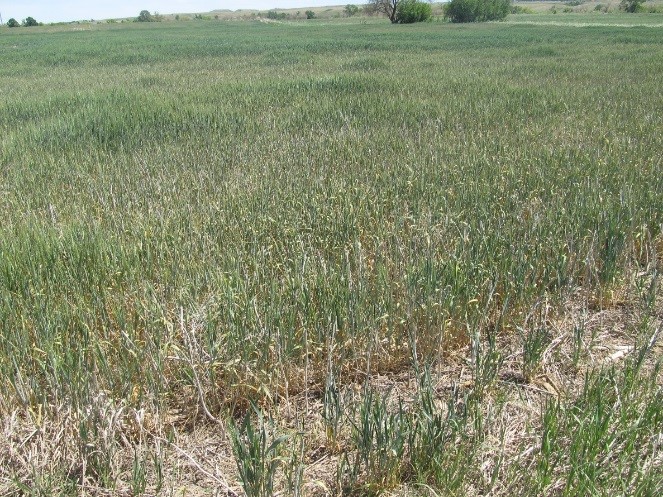Soil Fertility Concerns Following Haying of Crop Fields
2017 will be remembered for widespread low wheat yields and shortages of hay for livestock in vast areas of North Dakota, due to drought. Prolonged drought conditions left producers with little choice but to salvage what they could from their fields. Many wheat fields were either hayed before maturity or the residue/straws were removed as hay following harvest. Even areas where residue or stubble normally would have been left in the fields for snow capture and water conservation, or erosion control were removed.

Drought stressed wheat.
Photo courtesy: Ryan Buetow, Area Extension Specialist at the Dickinson Research Extension Center
Some perspectives on residue removal
- Crop residues, left in the field, are major sources of soil organic carbon and soil nutrients which enhance microbial activity, improve soil structure and water retention.
- The most visible effect from removal is soil erosion, which is worsened by annual residue removal.
- To determine the amount of nutrients removed from the field when a crop is baled, follow procedures to take a sample of the bale for analysis, weigh the bale, and determine dry weight (moisture content) of the bale. Sampling protocol available at: http://foragetesting.org/files/hayprotocol.pdf. Or visit the NDSU Extension publication: https://www.ag.ndsu.edu/livestockextension/ranch-hand-newsletter/sampling-feeds-and-testing-for-nutritional-value.
If farmers baled their fields this year, should they be concerned about nutrient deficiencies for the next cropping season?
The answer is no, only if farmers test their soils to know what the current nutrient levels are, even if the soil test levels were high in spring of 2017. Without soil test results, farmers should be concerned especially about macro nutrients like potassium (K) and phosphorus (P) that are sometimes not included in the farmer’s regular fertilization plans. Without soil sampling and testing adequate fertilizer recommendations cannot be made.
K and P fertilizer application may be necessary following residue removal
- Application of K fertilizer will surely be required for soils that had medium to low levels of K (120 ppm or 240 lbs or less in the top 6 inches) at the start of the 2017 cropping season because of high K content in residues.
- Wheat contains a relatively higher proportion of K in the residue than in the grain (about 400% more). For example: a 35-bushel wheat yield removes about 11 lbs of K2O/ac with the grain and will leave about 55 lbs K2O in the residue. When residue is baled, soil K levels can drop significantly.
- Loss of top-soil through wind erosion can cause a reduction of both P and K in the soil.
For fields where whole plants were removed this summer or fall, potash (K) application may be necessary and hay analysis may be necessary with soil testing. For fields where grains only were removed, short term fertilizer planning will depend primarily on soil test results.
Jasper Teboh, Ph. D.
jasper.teboh@ndsu.edu
Research Soil Scientist


